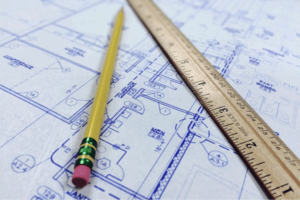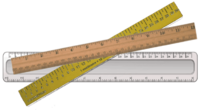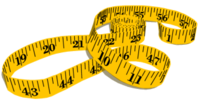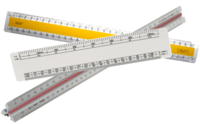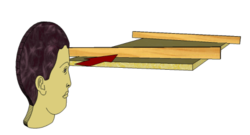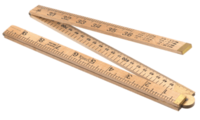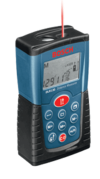Rules and Straight Edges: Difference between revisions
From DT Online
m (DT Online moved page Rules to Rules and Straight Edges without leaving a redirect) |
No edit summary |
||
| (10 intermediate revisions by the same user not shown) | |||
| Line 1: | Line 1: | ||
[ | [[File:PencilRuler.png|300px|right]] | ||
__TOC__ | |||
=====Description===== | |||
[http://en.wikipedia.org/wiki/Ruler '''Rules'''] or '''Rulers''' are used for taking or transferring measurements and a variety of designs are available for specific purposes. Some '''Rules''' are used also as a '''Straight Edge''' with which to mark lines or test for straightness. | |||
=====Features and Applications===== | |||
{| | {| | ||
|- | |- | ||
| [http:// | | [http://en.wikipedia.org/wiki/Ruler '''Desk Ruler'''] | ||
| | | General purpose rulers, usually 30cm long and available in wood or plastics or a combination of these materials ''(e.g. wooden body and plastics edge for greater durability)''. | ||
---- | |||
<span style="color: blue">'''Activity:''' | |||
Try holding a '''[[Squares|Set Square]]''' against a ruler and sliding it along to see that parallel lines can be drawn in this way. | |||
</span> | |||
---- | |||
| [[File:DeskRuler.png|200px|right]] | | [[File:DeskRuler.png|200px|right]] | ||
|- | |- | ||
| [http://www.example.com '''Steel Rule''] | | [http://www.example.com '''Steel Rule'''] | ||
| | | The main rule for general workshop use, usually made from [http://www.example.com '''Stainless Steel''']. '''Steel Rules''' are commonly available in a range of sizes including 150mm, 300mm, 600mm and 1000mm. They are also used as '''Straight Edges''' when marking lines or testing for straightness. | ||
---- | |||
<span style="color: green">'''Note:''' | |||
For greatest accuracy use a '''Steel Rule''' with a '''[[Scriber]]''' and tilt the rule such that the scriber can run along the engraved marking and on to the workpiece. | |||
</span> | |||
---- | |||
<span style="color: blue">'''Activity:''' | |||
First ensure the machine is isolated then grip a small 150mm rule against a turned bar held in a lathe chuck with the lathe tool. The blade will be held vertically if the tool is set exactly on centre and the upper part will tilt forward or backwards if set high or low respectively. | |||
</span> | |||
---- | |||
| [[File:SteelRule.png|200px|right]] | | [[File:SteelRule.png|200px|right]] | ||
|- | |- | ||
| | | '''[[Safety Ruler]]''' | ||
| | | These rules have a depression along their centre to ensure fingers are located away from the edge as the rule is used to guide a '''[[Craft Knife]]''' when cutting materials such as paper or card. They should be used in conjunction with a '''[[Cutting Mat]]''' | ||
| [[File:SafetyRuler.PNG|200px|right]] | | [[File:SafetyRuler.PNG|200px|right]] | ||
|- | |- | ||
| [http:// | | [http://en.wikipedia.org/wiki/Tape_measure '''Tape Measure ''(cloth tape)'''''] | ||
| | | Usually made from flexible cloth or plastic, these '''Tape Measures''' are in common use for dressmaking and tailoring when needing to take a person's measurements. | ||
| [[File:ClothTape.png |200px|right]] | | [[File:ClothTape.png |200px|right]] | ||
|- | |- | ||
| [http:// | | [http://en.wikipedia.org/wiki/Tape_measure '''Steel Tape Rule'''] | ||
| Retractable '''Steel Tape Rules''' are now used universally for general measurements around the home and for many craft trades both in the workshop and when working on site. Some tape measures are now available with a digital read-out | |||
| [[File:TapeMeasure.png| | | [[File:TapeMeasure.png|125px|right]] | ||
|- | |- | ||
| [http:// | | [http://en.wikipedia.org/wiki/Engineer%27s_scale '''Scale Rule'''] | ||
| | | Drawings are produced to '''[[Scales|Scale]]''' whenever the product is too big conveniently to fit on paper at full-size or ''(true-size)''. '''Scale Rules''' are used by [http://en.wikipedia.org/wiki/Architect '''Architects'''], [http://en.wikipedia.org/wiki/Engineer '''Engineers'''] and others to read the actual size of a dimension directly off a scale drawing. | ||
| [[File:ScaleRules.png|200px|right]] | | [[File:ScaleRules.png|200px|right]] | ||
|- | |- | ||
| [http:// | | [http://en.wikipedia.org/wiki/Winding_stick'''Winding Sticks'''] | ||
| | | Usually home made, these are simply two very straight and parallel lengths of timber ''(but other materials can also be used)''. One ‘stick’ is placed across one end of a board and another across the opposite end. By sighting along them any twist or '''‘wind’''' can more easily be seen. '''Winding Sticks''' are typically about 400mm long and 30mm wide but the longer they are the more they will amplify any winding or twisting of the board. | ||
| [[File:WindingSticks.png|250px|right]] | |||
|- | |||
| [http://en.wikipedia.org/wiki/Ruler '''Folding Rule'''] | |||
| Used for measuring larger distances, these are still in common use by [http://en.wikipedia.org/wiki/House_painter_and_decorator '''Painters and Decorators'''] ''(perhaps because they can be unfolded with one hand)'' but otherwise they have largely been superceded by '''Steel Tape Rules''' | |||
| [[File:DecoratorsFoldingRule.png|200px|right]] | | [[File:DecoratorsFoldingRule.png|200px|right]] | ||
|- | |||
| '''Laser Measures''' | |||
| These are becoming increasingly common for measuring larger distances very accurately - in addition, they can calculate areas or volumes. '''Ultra-sonic''' measures are also available. These are less expensive but are not as accurate and are easily interrupted by obstacles. | |||
| [[File:LaserMeasurer.png|100px|right]] | |||
|} | |} | ||
{{Rules Buyers Guide}} | |||
[[Category:Primary]] | |||
[[Category:Secondary]] | |||
[[Category:Marking and Measuring Tools]] | |||
Latest revision as of 12:08, 4 February 2017
Description
Rules or Rulers are used for taking or transferring measurements and a variety of designs are available for specific purposes. Some Rules are used also as a Straight Edge with which to mark lines or test for straightness.
Features and Applications
| Desk Ruler | General purpose rulers, usually 30cm long and available in wood or plastics or a combination of these materials (e.g. wooden body and plastics edge for greater durability).
Activity: Try holding a Set Square against a ruler and sliding it along to see that parallel lines can be drawn in this way. |
|
| Steel Rule | The main rule for general workshop use, usually made from Stainless Steel. Steel Rules are commonly available in a range of sizes including 150mm, 300mm, 600mm and 1000mm. They are also used as Straight Edges when marking lines or testing for straightness.
Note: For greatest accuracy use a Steel Rule with a Scriber and tilt the rule such that the scriber can run along the engraved marking and on to the workpiece. Activity: First ensure the machine is isolated then grip a small 150mm rule against a turned bar held in a lathe chuck with the lathe tool. The blade will be held vertically if the tool is set exactly on centre and the upper part will tilt forward or backwards if set high or low respectively. |
|
| Safety Ruler | These rules have a depression along their centre to ensure fingers are located away from the edge as the rule is used to guide a Craft Knife when cutting materials such as paper or card. They should be used in conjunction with a Cutting Mat | |
| Tape Measure (cloth tape) | Usually made from flexible cloth or plastic, these Tape Measures are in common use for dressmaking and tailoring when needing to take a person's measurements. | |
| Steel Tape Rule | Retractable Steel Tape Rules are now used universally for general measurements around the home and for many craft trades both in the workshop and when working on site. Some tape measures are now available with a digital read-out | |
| Scale Rule | Drawings are produced to Scale whenever the product is too big conveniently to fit on paper at full-size or (true-size). Scale Rules are used by Architects, Engineers and others to read the actual size of a dimension directly off a scale drawing. | |
| Winding Sticks | Usually home made, these are simply two very straight and parallel lengths of timber (but other materials can also be used). One ‘stick’ is placed across one end of a board and another across the opposite end. By sighting along them any twist or ‘wind’ can more easily be seen. Winding Sticks are typically about 400mm long and 30mm wide but the longer they are the more they will amplify any winding or twisting of the board. | |
| Folding Rule | Used for measuring larger distances, these are still in common use by Painters and Decorators (perhaps because they can be unfolded with one hand) but otherwise they have largely been superceded by Steel Tape Rules | |
| Laser Measures | These are becoming increasingly common for measuring larger distances very accurately - in addition, they can calculate areas or volumes. Ultra-sonic measures are also available. These are less expensive but are not as accurate and are easily interrupted by obstacles. |
 |
 |
 |
 |
 |
 |
 |
 |
 |
 |
| 300mm Steel Rule |
150mm Steel Rule |
600mm Steel Rule |
Safety Rule |
Tape Measure |
Shatter Resistant Ruler |
Scale Ruler |
Measuring Tape |
Folding Wooden Rule |
Digital Laser Measure |
